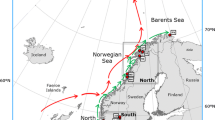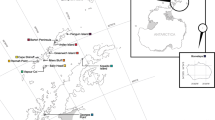Abstract
The Lake Saimaa ringed sealPhoca hispida saimensis has lived as anisolated landlocked population in easternFinland since the early post-glacial. In thelast century, the population crashed down to c.200 individuals, and is under a constant threatof extinction. We evaluated the genetic historyof the Saimaa population through a comparisonwith the conspecific sister populations in theArctic Ocean and the Baltic Sea, which haveretained high levels of variation since thedeglaciation. At eight microsatellite loci, thecurrent gene diversity (heterozygosity) of theSaimaa seal was 69% lower than in thereference populations. Allowing reasonablemutation rates (μ = 10−4), thisimplies a long-term post-glacial effectivepopulation size of N e ≃ 350,and a slow average rate of inbreeding ΔF≃ 0.15% per generation during the c.860 generations (9 500 years) of isolation. Thecurrent N e is an order of magnitudesmaller and ΔF correspondinglylarger. Whereas the additional loss of markervariation in the short term will not be highrelative to that already taken place, it seemsunwarranted to suppose that the past, slowinbreeding would have effectively purged thepopulation of genetic load and reduced thegenetic risks from small population size.Although the population is now clearlygeographically subdivided in the complex lakesystem, we found little genetic differentiationbetween main breeding areas (F ST =0.02). However, at the current low populationdensities, the subdivision may markedly furtherincrease the future rate of inbreeding.
Similar content being viewed by others
References
Allen PJ, Amos W, Pomeroy PP, Twiss SD (1995) Microsatellite variation in grey seals (Halichoerus grypus) shows evidence of genetic differentiation between two British breeding colonies. Mol. Ecol., 4, 653–662.
Ballou JD (1997) Ancestral inbreeding only minimally affects inbreeding depression in mammalian populations. J. Hered., 88, 169–178.
Balloux F (2001) easypop (version 1.7), A computer program for population genetics simulation. J. Hered., 92, 301–302.
Berthier P, Beaumont MA, Cornuet JM, Luikart G (2002) Likelihood-based estimation of the effective population size using temporal changes in allele frequencies: A genealogical approach. Genetics, 100, 741–751.
Bruford MW, Hanotte O, Brookfield JFY, Burke T (1992) Singlelocus and multilocus DNA fingerprinting. In: Molecular Genetic Analysis of Populations. A Practical Approach (ed. Hoelzel AR), pp. 225–269. Oxford University Press, Oxford/New York/ Tokyo.
Bürger R, Lynch M (1997) Adaptation and extinction in changing environments. In: Environmental Stress, Adaptation and Evolution (eds. Bijlsma R, Loeschke V), pp. 209–239. Birkhäuser Verlag, Basel, Switzerland.
Charlesworth B (1998) Measures of divergence between populations and the effect of forces that reduce variability. Mol. Biol. Evol., 15, 538–543
Charlesworth D, Charlesworth B (1987) Inbreeding depression and its evolutionary consequences. Annu. Rev. Ecol. Syst., 18, 237–268.
Coltman DW, Bowen WD, Wright JM (1998) Birth weight and neonatal survival of harbour seal pups are positively correlated with genetic variation measured by microsatellites. Proc. R. Soc. Lond., Ser. B: Biol. Sci., 265, 803–809.
Coltman DW, Pilkington JG, Smith JA, Pemberton JM (1999) Parasite-mediated selection against inbred Soay sheep in a freeliving, island population. Evolution, 53, 1259–1267.
Comps B, Gömöry D, Letouzey J, Thiébaut T, Petit RJ (2001) Diverging trends between heterozygosity and allelic richness during postglacial colonization in the European Beech. Genetics, 157, 389–397.
Cornuet JM, Luikart G (1996) Description and power analysis of two tests for detecting recent population bottlenecks from allele frequency data. Genetics, 144, 2001–2014.
Crnokrak P, Roff DA (1999) Inbreeding depression in the wild. Heredity, 83, 260–270.
Donner J (1995) The Quaternary History of Scandinavia. Cambridge University Press, Cambridge, UK.
Eldridge MDB, King JM, Loupis AK, Spencer PBS, Taylor AC, Pope LC, Hall GP (1999) Unprecedented low levels of genetic variation and inbreeding depression in an island population of the black-footed rock-wallaby. Cons. Biol., 13, 531–541.
Estoup A, Angers B (1998) Microsatellites and minisatellites for molecular ecology: Theoretical and empirical considerations. In: Advances in Molecular Ecology (ed. Carvalho GR). IOS Press, Amsterdam, Netherlands.
Forstén A, Alhonen P (1975) The Subfossil seals of Finland and their relation to the history of the Baltic Sea. Boreas, 4, 10–22.
Frankham R (1995) Effective population size/adult population size ratios in wildlife: A review. Genet. Res., 66, 95–107.
Franklin IR (1980) Evolutionary changes in small populations. In: Conservation Biology (eds. Soulé ME, Wilcox BA), pp. 135–149. Sinauer, Sunderland, MA.
Franklin IR, Frankham R (1998) How large must populations be to retain evolutionary potential? Anim. Cons., 1, 69–73
Garza JC, Williamson EG (2001) Detection of reduction in population size using data from microsatellite loci. Mol. Ecol., 10, 305–318.
Gilligan DM, Woodworth LM, Montgomery ME, Briscoe DA, Frankham R (1997) Is mutation accumulation a threat to the survival of endangered populations? Cons. Biol., 11, 1235–1241.
Goodman SJ (1997) Dinucleotide repeat polymorphisms at seven anonymous microsatellite loci cloned from the European harbour seal (Phoca vitulina vitulina). Anim. Genet., 28, 310–311.
Gotelli D, Sillero Zubiri C, Applebaum GD, Roy MS, Girman DJ, Garcia Moreno J, Ostrander EA, Wayne RK (1994) Molecular genetics of the most endangered canid: The Ethiopian wolf Canis simensis. Mol. Ecol., 3, 301–312.
Goudet J (1995) FSTAT version 1.2: A computer program to calculate F-statistics. J. Hered., 86, 485–486.
Hartl DL, Clark AC (1997) Principles of Population Genetics. Sinauer, Sunderland, MA.
Hedrick PW (1994) Purging inbreeding depression and the probability of extinction: Full-sib mating. Heredity, 73, 363–372.
Hoelzel AR (1999) Impact of population bottlenecks on genetic variation and the importance of life-history; a case study of the northern elephant seal. Bio. J. Linn. Soc., 68, 23–39.
Hoelzel AR, LeBoeuf BJ, Campagna C, Reiter J (1999) Alpha male paternity in elephant seals. Behav. Ecol. Sociobiol., 46, 298–306.
Houlden BA, England PR, Taylor AC, Greville WD, Sherwin WB (1996) Low genetic variability of the koala Phascolarctos cinereus in south-eastern Australia following a severe population bottleneck. Mol. Ecol., 5, 269–281.
Hyvärinen H, Nieminen M (1990) Differentiation of the ringed seal in the Baltic Sea, Lake Ladoga and Lake Saimaa. Finnish Game Res., 47, 21–27.
Hyvärinen H, Sipilä T (1992) Saimaannorppa Phoca (Pusa) hispida saimensis. In: Maailman uhanalaiset eläimet (ed. Elo U), pp. 68–71. Weilin &; Göös, Vantaa.
Järvinen O, Varvio SL (1985) Proneness to extinction of small populations of seals: Demographic and genetic stochasticity vs. environmental stress. Finnish Game Res., 44, 6–18.
Kirkpatrick M, Jarne P (2000) The effects of a bottleneck on inbreeding depression and the genetic load. Am. Nat., 155, 154–167.
Kokko H, Lindström J, Ranta E (1997) Risk analysis of hunting of seal populations in the Baltic. Cons. Biol., 11, 917–927.
Kokko H, Lindström J, Ranta E, Sipilä T, Koskela J (1998) Estimating the demographic effective population size of the Saimaa ringed seal (Phoca hispida saimensis Nordq.). Anim. Conserv., 1, 47–54.
Kokko H, Helle E, Lindström J, Ranta E, Sipilä T, Courchamp F (1999) Backcasting population sizes of ringed and grey seals in the Baltic and Lake Saimaa during the 20th century. Ann. Zool. Fenn., 36, 65–73.
Koskela JT, Kunnasranta M, Hämäläinen E, Hyvärinen H (2002) Movements and use of haul-out sites of radio-tagged Saimaa ringed seal (Phoca hispida saimensis Nordq.) during the openwater season. Ann. Zool. Fenn., 39 (in press).
Kunnasranta M (2001) Behavioural Biology of Two Ringed Seal (Phoca hispida) Subspecies in the Large European Lakes Saimaa and Ladoga. PhD thesis. University of Joensuu, Joensuu, Finland.
Kuusisto E (1999) Basins and balances. In: Saimaa–A Living Lake (ed. Kuusisto E.), pp. 21–39. Tammi, Helsinki
Lacy RC (1997) Importance of genetic variation to the viability of mammalian populations. J. Mammal., 78, 320–335.
Lande R (1995) Mutation and conservation. Cons. Biol., 9, 782–791.
Luikart G, Cornuet JM (1998) Empirical evaluation of a test for identifying recently bottlenecked populations from allele frequency data. Cons. Biol., 12, 228–237.
Nieminen M, Singer MC, Fortelius W, Schöps K, Hanski I (2001) Experimental confirmation that inbreeding depression increases extinction risk in butterfly populations. Am. Nat., 157, 237–244.
Paetkau D, Waits LP, Clarkson PL, Craighead L, Vyse E, Ward R, Strobeck C (1998) Variation in genetic diversity across the range of North American brown bears. Cons. Biol., 12, 418–429.
Palo JU, Mäkinen HS, Helle E, Stenman O, Väinölä R (2001) Microsatellite variation in ringed seals (Phoca hispida): Genetic structure and history of the Baltic Sea population. Heredity, 86, 609–617.
Ranta E, Lindström J, Kokko H (1996) Ecological risk analysis: The case of the Saimaa ringed seal. Ambio, 25, 363–365.
Raymond M, Rousset F (1995) GENEPOP (version 1.2): population genetics software for exact tests and ecumenicism. J. Hered., 86, 248–249.
Reijnders P, Brasseur S, van de Toorn J, van de Wolf P, Boyd I, Harwood J, Lavigne D, Lowry LL (1993) Status survey and Conservation Action Plan: Seals, Fur Seals, Sea Lions, and Walrus. The World Conservation Union IUCN.
Simonsen V, Allendorf FW, Eanes WF, Kapel FO (1982) Electrophoretic variation in large mammals. III. The ringed seal, Pusa hispida, the harp seal, Pagophilus groenlandicus, and the hooded seal, Cystophora cristata. Hereditas, 97, 87–90.
Sipilä T (1990) Lair structure and breeding habitat of the Saimaa ringed seal (Phoca hispida saimensis Nordq.) in Finland. Finnish Game Res., 47, 11–20.
Sipilä T, Koskela J (2001) Saimaannorppien esiintymisalue keskittyy. Saimaan Luonto, 16, 5–7.
Sipilä T, Helle E, Hyvärinen H (1990) Distribution, population size and reproductivity of the Saimaa ringed seal (Phoca hispida saimensis Nordq.) in Finland, 1980–1984. Finnish Game Res., 47, 3–10.
Smith TG (1973) population dynamics of the ringed seal in the Canadian Eastern Arctic. Bull. Fish. Res. Board Canada, 181, 1–55.
Taylor AC, Sherwin WB, Wayne RK (1994) Genetic variation of microsatellite loci in a bottlenecked species: The northern hairynosed wombat Lasiorhinus krefftii. Mol. Ecol., 3, 277–290.
Ukkonen P (2002) The early history of seals in the northern Baltic. Ann. Zool. Fenn., 39, in press.
Weir BS, Cockerham CC (1984) Estimating F-statistics for the analysis of population structure. Evolution, 38, 1358–1370.
Author information
Authors and Affiliations
Corresponding author
Rights and permissions
About this article
Cite this article
Palo, J., Hyvärinen, H., Helle, E. et al. Postglacial loss of microsatellite variation in the landlocked Lake Saimaa ringed seal. Conservation Genetics 4, 117–128 (2003). https://doi.org/10.1023/A:1023303109701
Issue Date:
DOI: https://doi.org/10.1023/A:1023303109701




